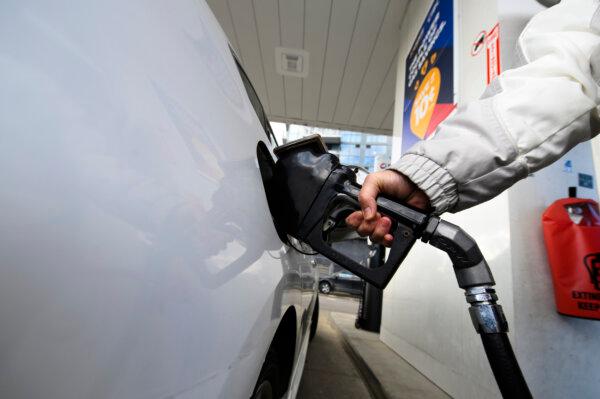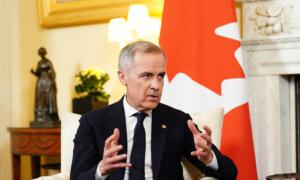News Analysis
While Prime Minister Mark Carney has so far been preoccupied with the response to U.S. tariffs and differentiating himself with the previous Liberal prime minister, he is expected to also focus substantially on net-zero emissions policies, as he has indicated on the campaign trail and given his past high-level roles on the file.
Carney’s first act as prime minister was bringing the rate for carbon tax for consumers, small businesses, and farms to zero, saying it had become a “divisive” issue. Meanwhile, he has made it clear that he will have comprehensive net-zero emissions policies, which includes putting a price on carbon for industrial players.
Values as Private Citizen and Stance as Politician
Carney, who after stepping down as the governor of Bank of England in 2020 became the U.N. Special Envoy on Climate Action and Finance, outlined his vision on how to build a better world in his 2021 book “Value(s).”
“I wrote Value(s) because I believed, even before Covid struck, that we needed radical changes to build a better world for all,” reads the preface of the book.
“The experience of Covid has reinforced the public’s desire for sustainability. The world began to translate this resolve into climate action in Glasgow at the UN Climate Change Conference (COP26) last November [2021], starting to turn what the Industrial Revolution has wrought into the sustainable revolution that our kids and grandkids deserve.”
Carney co-led the development of the Financial Alliance for Net Zero which was formed during the conference in Glasgow. The organization commits members, which include banks and other financial institutions, to align their lending and investments with objectives for “net-zero greenhouse gas emissions by 2050.”
In his book, Carney says financial institutions should commit to backing companies that have “credible plans to transform their businesses for a net-zero world.” This includes companies in “heavy emitting sectors,” he wrote, such as steel, cement, and transportation.
He said that net-zero investments can be a huge opportunity for Canada, bringing jobs and enabling growth for the economy. He says some of these jobs can be realized in the creation of a “zero-carbon electricity grid,” accelerating the adoption of electric vehicles, increasing energy efficiency of homes and offices, and with projects involving hydrogen as an energy source and carbon capture.

Mark Carney makes a keynote address to launch the private finance agenda for the 2020 U.N. Climate Change Conference (COP26) at Guildhall in London, England, on Feb. 27, 2020. Tolga Akmen/WPA Pool/Getty Images
Carney praised Canada’s carbon tax scheme brought in by the Trudeau government, as well as the mandates for the sale of EVs and net-zero electricity grid which were highly contested by Alberta and Saskatchewan.
“Effective public policies include carbon prices such as Canada’s legislated path to $170/tonne in 2030 with the proceeds rebated to Canadians, and our commitments to a clean grid and clean cars by 2035,” he said.
“And we can help build a new international economy. Cross-border trade in goods, services, capital and carbon will increasingly align with countries’ shared values.”
During the Liberal leadership campaign, Carney said he will use “incentives,” instead of “penalties,” to get people to lower their carbon footprint, while making “biggest emitters” pay.
He also said he’ll provide funding for making buildings more energy efficient, as well as boost the use of electric vehicles. As well, he has said his government would ensure “fairness for Canadian industries on the global stage,” and better integration “with allies in the fight against climate change.”
In his victory speech after winning the Liberal leadership race on March 9, he said he has a plan to make Canada an “energy superpower in both clean and conventional energy.”
New Mechanisms
Carney’s initial plan to reduce greenhouse gas emissions released during the Liberal leadership campaign seeks to expand some of the measures and policies put in place by the federal government during the tenure of former Prime Minister Justin Trudeau.
The plan also in some cases goes beyond current policies by proposing new mechanisms, such as imposing a tariff on foreign goods which do not meet certain emissions standards.
This measure is called the carbon border adjustment mechanism. The stated purpose is to help Canadian industries being affected by carbon pricing to compete with other countries which do not have such a policy.
Carney said in Europe this week that implementing carbon policies is a requirement to diversify trade away from the United States, which has already slapped two sets of tariffs on Canada.
“Guess what one of the requirements is to diversify trade to the European Union?” Carney said in London, England, on March 17 in reference to carbon pricing, while adding that the United Kingdom also has a similar requirement.
The European Union plans to implement its carbon border adjustment mechanism in 2026. The U.K.’s levy on imports related to carbon pricing is set to come into force in 2027.
Jason Kenney, former Premier of the oil-rich province of Alberta and former minister under Conservative Prime Minister Stephen Harper, rejected Carney’s assertion, and said that the Harper government was able to negotiate trade pacts without such requirements.
But if in the coming years emissions objectives will be a true barrier to trade pacts with Europe, it stands in contrast with British Prime Minister Keir Starmer visiting the United States last month eager for a trade deal with the Trump administration, which has pulled his country out of the Paris Agreement.
Fuel Charge
Carney has been a strong proponent of carbon pricing, but he pledged during his leadership campaign to remove the carbon tax which applies to consumers and small businesses. He followed through shortly after he was sworn-in as prime minister on March 14, by bringing the rate for consumers to zero. Since Parliament is not currently sitting after being prorogued until March 24 by Trudeau, the Liberals cannot remove the legislation.

A man pumps gas into his vehicle at a gas station in Mississauga, Ont., on Feb. 13, 2024. The Canadian Press/Christopher Katsarov
The fuel charge currently adds over 17 cents to a litre of gasoline in some provinces and it was set to increase to over 20 cents on April 1.
Carney has not said the measure is ineffective in reducing emissions, but that it had “become very divisive for Canadians.”
“It’s the perceptions of the impact, the negative impacts of the carbon tax on households without fully recognizing the positive impacts of the rebate, has made this more of a divisive issue,” he said. “It’s been fed by misinformation and lies, quite frankly, by the Leader of the Opposition.”
Conservative Leader Pierre Poilievre has said the carbon tax has made Canadians poorer, a stance shared by the Parliamentary Budget Officer (PBO) Yves Giroux based on his analysis. Liberals have argued that a majority of households got more in carbon rebates than they paid in carbon tax. This has also been deemed accurate by the PBO, but when measuring the full economic impact of the tax as it increases the costs of everything from production to transportation, most households see a net loss, said Giroux.
Carney does not intend to get rid of the carbon pricing which applies to industry. Instead, his plan to compensate for the removal of the fuel charge, which impacts consumers and small businesses, is to make “big polluters pay.”
His plan calls to “improve and tighten” what is called the Output-Based Pricing System for large industrial emitters. It would also be linked to a new consumer carbon credit market that industrial emitters can pay into. This could lead to credit oversupply, which would be managed by tightening emissions targets, resulting in increased fuel prices.
Conservatives have called this the “shadow carbon tax,” and say the new prime minister isn’t being forthcoming with his true plan. Carney, for his part, says the Tories want to “allow our planet to burn.”
Poilievre said his government would do away with the “entire carbon tax.”
Poilievre had made “axing” the carbon tax a key policy plank and slogan in recent years and said on March 10 his policy on carbon pricing for industry would be released in the upcoming electoral campaign.
He went ahead with the announcement on March 17 and said removing the tax on industry is necessary to rebuild Canada’s industrial base as the country deals with a trade conflict with its largest trading partner the United States.
“With lower taxes, we will unleash a massive boom and bring home paycheques and production from the U.S. and other countries,” said Poilievre, who added that technology and not taxes should be used to lower emissions.

Conservative Leader Pierre Poilievre speaks at a rally in Ottawa on Feb. 15, 2025. The Canadian Press/Justin Tang
Alberta Premier Danielle Smith has said that Carney’s plan to shift the costs to the industrial sector will be damaging to the economy and raise costs for businesses.
Smith also charged that Carney wants to keep “oil and gas in the ground.” She has been very critical of the federal government’s regulations on energy, including imposing limits on emissions in the oil and gas sector.
Her province has taken legal action against the feds’ Impact Assessment Act, a law that requires certain environmental evaluations be performed on major projects such as pipelines, which the government of Alberta says in effect kills major projects due to the regulatory burden.
Carney has defended the Impact Assessment Act on the campaign trail, saying it has the necessary provisions to fast-track projects as needed.
Carney has said he wants to also strengthen commitments around oil and gas methane emissions. Current federal targets seek to reduce emissions by at least 75 percent by 2030, from 2012 levels.
Low- and No-Carbon Projects
If Carney and Poilievre disagree on carbon taxes, they agree on the need to remove hurdles to develop energy projects with no emissions. Poilievre has repeatedly called for removing obstacles to building homes or energy projects, and he has also said he would “give the green light to green projects.”
Carney has promised in his climate plan to reform federal permitting through legislation and “cut red tape to speed up approvals of clean energy projects, including new electricity developments across generation, transmission, distribution, and storage.”
Carney also wants to boost expenditure in low carbon projects and industries and has proposed several related methods.
He said he plans to use “Carbon Contracts for Difference,” an arrangement under which the government backs emissions-reduction projects with financial guarantees if the price on carbon doesn’t reach the $170 per tonne benchmark by 2030.
Carney also wants to mandate companies to disclose “climate risk” associated to their activities in a bid to steer investments towards industries which emit less carbon.
The Carney government also intends to establish “Made-in-Canada Sustainable Investment Guidelines” which will identify industries deemed to be in “transition” away from hydrocarbons, such as transportation and agriculture.
Consumer Measures
Along with a plan for industry, Carney pledged to renew several incentives put in place by his predecessor to encourage consumers to lower their carbon footprint.
The federal subsidy of $5,000 for the purchase of zero-emission vehicles was put on pause in January after all funds were depleted. The program was due to end on March 31. Carney said he will reinstate the $5,000 subsidies but geared towards low and middle-income households.
Carney wants to inject new funding into the Greener Homes Grant, a program now closed to applicants which provided up to $5,000 in grants to homeowners performing retrofits on their properties. The plan says the new money would be targeted to lower income households.
Carney also wants to boost the subsidies provided for the replacement of oil furnaces with heat pumps. The program had been announced in the fall of 2023 at the same time Trudeau had paused the carbon tax on heating oil for three years, as he faced pressure from his Atlantic MPs.







